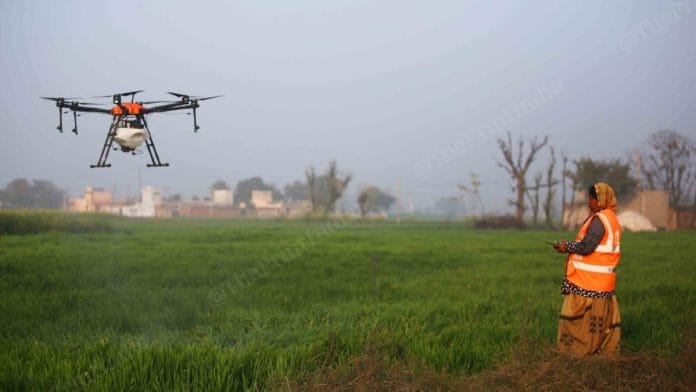New Delhi: Just 34 districts in 11 states are using drones for monitoring work sites under the Centre’s Mahatma Gandhi National Rural Employment Guarantee Scheme (MGNREGS), a year after the Union rural development ministry recommended its use for surveillance, as per the information available on the ministry’s website.
Officials in state governments cite several reasons for the limited use of drones in surveillance of MGNREGS work sites such as lack of availability of trained drone professionals, difficulty in using drones in areas with high tree canopy density, and large number of work sites among others.
The use of drones is among the initiatives taken by the Centre to push for the use of technology in surveillance of MGNREGS works to bring in transparency and accountability. Last year, the rural development ministry pushed for mandatory use of the Aadhaar-Based Payment System (ABPS) and National Mobile Monitoring System (NMMS) for payment of wages and attendance of workers, respectively.
In July last year, the ministry issued the standard operating procedure (SOP) for the use of drones in surveillance of work sites. As per the SOPs, drones can be used for four activities: monitoring of ongoing works, inspection of completed works, impact assessment of completed works and special inspection in case of a complaint.
As per the information available on the ministry’s MGNREGS dashboard, 11 districts in Uttar Pradesh, seven districts in Tamil Nadu, four in Telangana, three districts each in Bihar and Andhra Pradesh and one each in Madhya Pradesh, Jammu and Kashmir, Maharashtra, Jharkhand, Uttarakhand and Rajasthan have started the use of drones.
Senior officials in Bihar, Tamil Nadu and among other states said it is not possible to monitor work progress at all work sites due to the large number of projects taken up under MGNREGS.
In Uttar Pradesh, senior officials said, the work is yet to start while the Centre’s portal shows that drone monitoring is being done in 11 states.
Rural development officials in UP said that drones will be used for random checks and not regular monitoring of work sites.
“We couldn’t start the work due to the model code of conduct in place; the work will start soon. But the plan is to use drones in areas from where we are getting complaints or if district magistrates ask for it. Regular monitoring of work is not possible using drones,” a senior official with UP’s rural development department said.
While SOPs were issued by the Union rural development ministry in July last year, the progress on the use of drones in surveillance has been slow. Senior state government officials cite that unavailability of trained professionals is also a major factor.
“We started using drones for assessment of work and monitoring workers at the sites in December last year. One of the reasons for the slow pace of work is unavailability of trained professionals. A lot of empaneled companies are working in the agriculture sector. We are now trying to rope in women self-help groups (SHGs) for drone flying in selected work sites,” said a senior official with Tamil Nadu government’s rural development department.
In some states, drones are being used while planning new projects instead of monitoring purposes. For instance, in Bihar, drones are being used in river rejuvenation and canal desilting projects. “Using drones, we are able to identify the areas where desilting is required or where canal repair work is to be undertaken. We are yet to start using it for monitoring progress of work at work sites,” said a senior official in Bihar government’s rural development ministry.
In Kerala, the state government is yet to start using drones. According to a senior official, “We will not be able to use drones for monitoring purposes due to the tree cover in most sites. It is difficult to get work site images from drones…. We will try to use it in areas where water bodies are being developed,” said an official with Kerala government’s rural development department.
When asked about the slow pace of use of drone technology in MGNREGS, a senior rural development ministry official said, “We have shared the SOPs with the states. As of now, it is not mandatory to monitor all works using drone technology.”
The Narendra Modi government is firm on pushing for the use of technology for transparency and accountability in the implementation of the rural employment scheme under which assets worth Rs 8.24 crore have been constructed since its inception in 2006.
Centre’s tech push for MGNREGS
After attendance and payment of wages, the Union rural development ministry plans to use geospatial technology and artificial intelligence (AI) in monitoring and management of assets created under MGNREGS.
In March this year, the rural development ministry roped in IIT-Delhi for its BhuPRAHARI project for monitoring and management of assets.
“The project is aimed at leveraging ground and space-based geospatial technologies along with Artificial Intelligence to monitor and manage assets under the MGNREGS,” the ministry had said in a statement in March.
It is learnt that the pilot project will start soon in five or six districts.
Since 2017, the NDA government has been pushing for the use of technology in monitoring attendance of workers at work sites and payment of wages to workers despite stiff opposition from workers and civil society members.
In January 2023, the Centre pushed for mandatory use of the National Mobile Monitoring System (which was introduced in 2021) for marking attendance of workers and Aadhaar Based Payment System (which was introduced in 2017) for payment of wages, though some relaxation was given following protest by civil society members and concerns raised by state governments.
Since 1 January, 2024, the Union rural development ministry has made ABPS mandatory for payment of wages.
(Edited by Zinnia Ray Chaudhuri)
Also read: Modi 3.0 approves 3 cr more houses under PM Awas Yojana in rural & urban India






